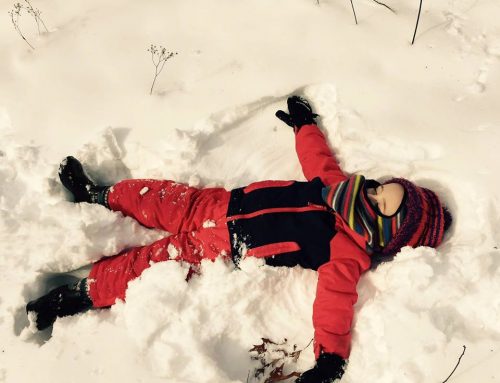Last week we posted a photo to our Facebook page showing our nature preschool children climbing up a snow covered ledge. Many people were surprised to see preschoolers happily trudging around in waist deep snow and climbing such a big ledge. The photo stands as a simple testament to what we mean when we say that DPNC has an unwavering commitment to getting our children outside every day.
Interestingly, just a day prior to our post, The Washington Post published a blog about the decline of recess in schools and the four things needed to fix it. Making time for outside play is not something we really need to fix at DPNC. It is something we excel at on most days. However, it is interesting to look at these four criteria and how adhering to these criteria leads us up big snow covered ledges with preschoolers.
Space: Children need space to explore and feel a sense of freedom. DPNC is at an advantage in this respect, having over 350 acres of open space to explore. At the preschool we have worked hard not to define our space by fences and traditional play equipment. We always leave our gated playground and find a space that the children would like to explore. They choose what looks appealing. “Can we stop and play here?” they will ask. We do a quick assessment and unless it is unsafe or we are out of time the answer is always yes!
Time: Children need extended and unstructured play sessions in order to invent games, problem solve, practice teamwork and get into the flow of play. Typically we have two hours outside every day. Getting all our outdoor gear on can cut into this time. Trying to do teacher led activities can also cut into this time. Maybe we need to skip a craft one day or forgo that second story. Maybe they don’t need a circle time at all and everything is telling us to get them outside and let them lead the way. While we always have ideas and activities that can extend our learning outside, more often than not, the children set the pace.
Trust: Children should have “adult-free” recess. This time should be driven by the children. In order to do this teachers need to trust the children’s abilities. This can be a difficult thing for well meaning adults to do, both in and out the classroom. Can children be trusted to use scissors? Swing on a branch? Balance on a log? Jump off a rock? Pour juice from a jug without spilling? Most importantly, can they be trusted to design their own activities and play independently? Do we trust that they are learning when teacher is not instructing? Research indicates that children learn and retain critical life skills when they make a discovery on their own. We also need the children to trust us. They know we will help them if they get hurt and encourage them if they are having difficulty with a task. They also know we will assess each situation and rules may change based on conditions. Sometimes rocks are “closed” for being too icy. Sometimes sticks are put away when they are used to poke or hit others. On our snowy ledge we found that the snow was deep and provided natural protection for any falls so it was full steam ahead.

Loose Parts: The final ‘fix’ for recess is to provide access to loose parts. Loose parts are open ended materials that children can use in their play. Loose parts can be materials that teachers provide like blocks, bottle caps, foam corks, popsicle sticks etc. Loose parts can also be found natural objects. Things like sticks, acorns, pine needles, catkins, bark and snow are our loose parts and there are always plenty of them to go around!
On this day we observed children developing endurance and confidence, helping each other, directing each other on the best route to take, problem solving a safe way down and expressing empathy when a child got hurt from a piece of snow that was thrown. Many of these things would not have been possible in the less challenging environment of a static playground.









